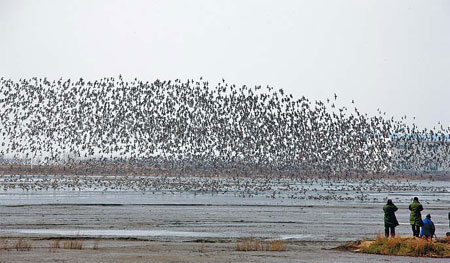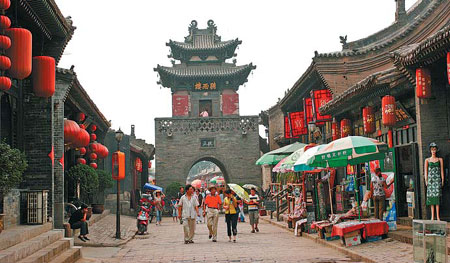Travel around
Cruise along
Updated:2012-09-30 08:09( China Daily)
|
The Yalu River Costal Wetland National Nature Reserve in Dandong is a heaven for migrant birds. Chen Hao / for China Daily |

With a number of regions in China scrapping toll charges on highways during one of the longest-ever National Day holiday, driving is perhaps the best way to see the country. Here are some suggested routes:
Route: Beijing - Tangshan - Qinhuangdao - Panjin - Shenyang - Fengcheng - Dandong
Spectacular journey to the east
By Mei Jia
If you are starting your journey from Beijing, drive to Tangshan in the neighboring Hebei province, where Kailuan National Mine Park is located. The earliest coal mine of China has stopped producing and the mining well is turned into a theme park for underground expeditions, where visitors can enjoy coffee at a cafe 30 meters under around.
From Tangshan, drive to Qinhuangdao in Hebei province where the Great Wall delves into the sea. After enjoying the spectacular view, make a stop at Panjin of Liaoning province to visit Shuangtaihekou National Nature Reserve and appreciate its distinctive "red seashore". The nature wonder is created by leaves of Suaeda salsa, a kind of seaweed that turns reddish purple in autumn.
Back on the road, the next stop is Liaoning's provincial capital Shenyang, where you can stay for a night to replenish your food and drink supplies.
Before approaching Dandong, pass by a city called Fengcheng, named after the picturesque Fenghuang (meaning phoenix in Chinese) Mountain. The mountain's steep cliffs attract many hikers who love challenges. Visiting in the autumn may reward you with the extra bonus of scenes of mountains covered with red and yellow leaves.
Dandong in Liaoning province is a city along the Yalu River bordering the Democratic People's Republic of Korea. Its scenic views, mild weather and mixed culture make it a popular driving destination for the week-long holiday. And because of the unpolluted water resources, Dandong is rich with tasty and fresh seafood. Along the route to Dandong, you will get to enjoy scenic and cultural spots in the country's northeast part.
The Yalu River bank in Dandong is also decorated with colorful lights at night. Along the bank, you can get to the broken bridge that used to connect China and DPRK, or you can peep at the sights on the other side of the river. Or take a river cruise for a relaxing tour of the city.
If time permits, Tianhua Mountain is another good choice. The mountain offers nice views, with clear and clean water running in between the valleys.
meijia@chinadaily.com.cn
|
Pingyao is a manifestation of Chinese wisdom in architecture. Yungang Grottoes (below) is a great spot to appreciate Buddhist stone carving. Liu Zhaoming / for China Daily |

Route: Beijing - Datong - Xinzhou - Taiyuan - Qixian - Pingyao
Best of ancient towns and temples
By Mei Jia
Toward the southwest of Beijing, Shanxi province is among the best choices for travelers who wish to travel by car during the Golden Week. The province boasts of the best of temples, ancient towns and traditional yards.
From Beijing, the first wonder along the route is ancient Yungang Grottoes in Datong's outskirt. Datong is also a historic city with rich mining resources.
The grottoes were built during the 5th to 6th century. Hailed as one of the four greatest grottoes in China, Yungang is the best spot to appreciate Buddhist stone carving and sculpture. It has some 250 caves bearing 51,000 figures.
Between Datong and Xinzhou city stands Wutai Mountain, a must stop to see some of China's most famous Buddhist temples. It's said that the five peaks in the area resemble the five upright fingers of Buddha, with Wutai Mountain acting as the palm. After building and rebuilding over several dynasties, the 95 temples on the mountains are examples of ancient architecture mixed with foreign style.
Stop by Shanxi's provincial capital Taiyuan, the haven of all kinds of wheaten foods for some gastronomy treat.
On the way to Pingyao ancient town, spare some time to visit a yard called The Qiao's. It is a wonderful model of a typical Jin (which stands for Shanxi) businessman's family compound, and northern China's residential architecture.
The final stop, Pingyao, is a collective manifestation of Confucian ideas and ancient wisdom in architecture. The town has 72 towers representing the 72 followers of Confucius, as well as retains the ancient layout and architectures of the Ming (1368-1644) and Qing (1644-1911) dynasties. Don't forget to sample some Pingyao beef, which is tender and rich in flavor.
meijia@chinadaily.com.cn
|
The night in Xitang is leisure and tranquil. Photos by Wang Hui / for China Daily |
Route: Shanghai - Jiashan
Original primitive water town
By Wang Hongyi in Shanghai
Imagine this: Waking up in the morning with the sound of water flowing beneath bridges and fresh air filling the environment.
Such poetic picture is not a fantasy but found in the ancient town of Xitang, near Shanghai.
It is the perfect spot to spend the holiday for those who do not fancy spending too much time on the road.
Located in Jiashan county, Zhejiang province, Xitang ancient town dates back to at least the Spring and Autumn Period (770-476 BC).
Unlike other ancient scenic towns nearby that are overly developed for tourism, Xitang manages to maintain its originality as a primitive water town.
The picturesque town appears to sparkle with river crisscrossing and the reflections of houses in the water exuding a sense of peace.
Well-preserved groups of buildings of the Ming (1368-1644) and Qing (1644-1911) dynasties with relatively high artistic quality and research value can be seen in Xitang.
The large amounts of ceilinged corridors, lanes and bridges are also the unique features of the water town.
wanghongyi@chinadaily.com.cn
|
Hairy crabs in Yangcheng Lake is a popular dish despite the escalating prices. Zhu Guigen / for China Daily |

Route: Shanghai - Yangcheng Lake
'Tis the season for hairy crabs
By Tang Zhihao in Shanghai
A leisure trip to Yangcheng Lake to enjoy some hairy crabs has become a regular feature for many Shanghai families in the autumn.
Hairy crabs from Yangcheng Lake, in northeast of Suzhou in Jiangsu province, are considered the best in China because of its clean environment and high nutrition. The annual output of Yangcheng Lake crabs is about 2,000 tons. Normally, the crab season lasts from late September until the end of December.
The price of crabs depends on their weight and not the number of crustaceans. In 2012, the average price for a 200-gram male crab is at least 80 yuan ($13), similar to prices in 2011. Prices of female crabs might be higher because of its delicious roes.
As market demand is much higher than the supply, there may be some fake products in the market. Authentic Yangcheng Lake crabs have a gray back with a slight black tinge, while their stomachs are pure white. The tips of the crabs' legs are golden.
There are more than 100 restaurants around Yangcheng Lake area to enjoy the delicious delicacy. Some restaurants allow visitors to catch the crabs themselves and they provide cooking services.
tangzhihao@chinadaily.com.cn

Pingyao smoked meat
Pingyao smoked meat is an indispensable dish for locals at banquets and it is also hugely popular with tourists.







